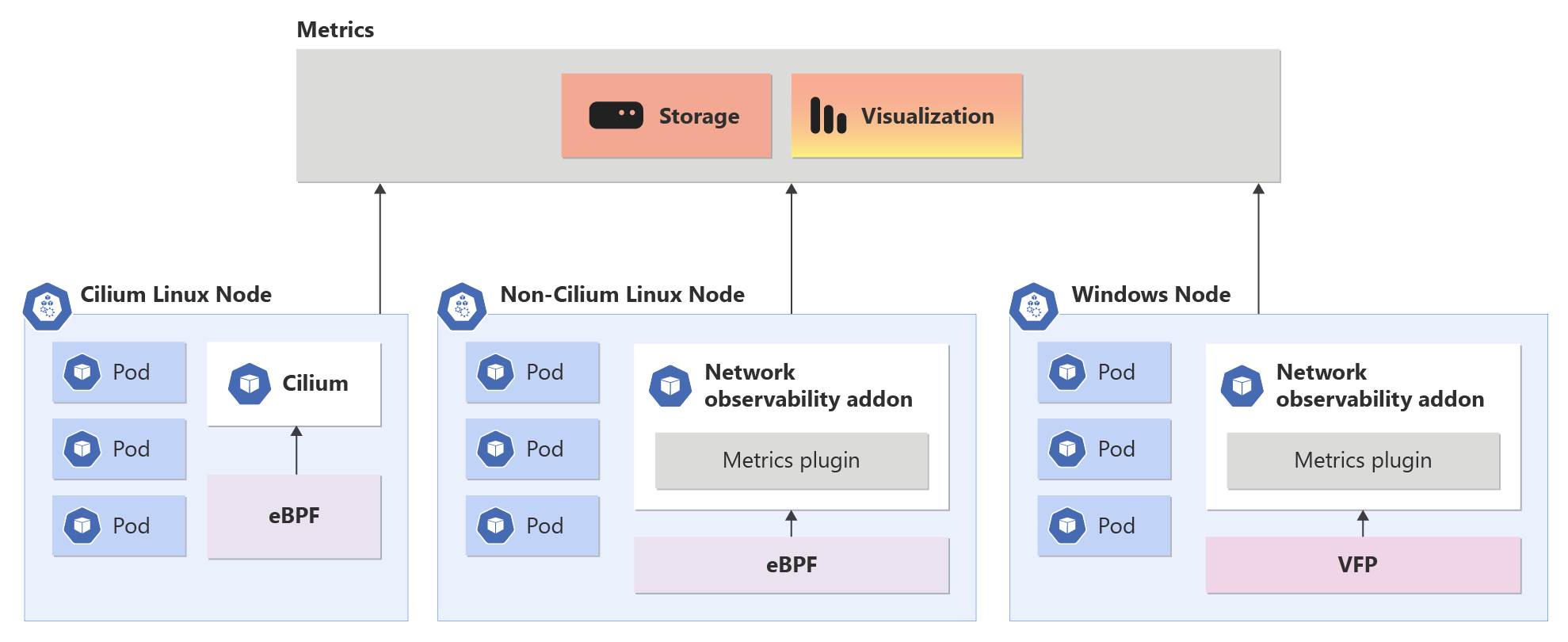What is Azure Kubernetes Service (AKS) Network Observability?
Kubernetes is a powerful tool for managing containerized applications. As containerized environments grow in complexity, it can be difficult to identify and troubleshoot networking issues in a Kubernetes cluster.
Network observability is an important part of maintaining a healthy and performant Kubernetes cluster. By collecting and analyzing data about network traffic, you can gain insights into how your cluster is operating and identify potential problems before they cause outages or performance degradation.

Overview of Network Observability add-on in AKS
Networking Observability add-on operates seamlessly on Non-Cilium and Cilium data-planes. It empowers customers with enterprise-grade capabilities for DevOps and SecOps. This solution offers a centralized way to monitor network issues in your cluster for cluster network administrators, cluster security administrators, and DevOps engineers.
When the Network Observability add-on is enabled, it allows for the collection and conversion of useful metrics into Prometheus format, which can then be visualized in Grafana. Azure has offerings for managed Prometheus and Grafana.
Azure managed Prometheus and Grafana: A managed service provided by Azure, taking care of the infrastructure and maintenance of Prometheus and Grafana, allowing you to focus on configuring and visualizing your metrics.
Multi CNI Support: Network Observability add-on supports both Azure CNI and Kubenet network plugins.
Metrics
Network Observability add-on currently only supports node level metrics in both Linux and Windows platforms. The below table outlines the different metrics generated by the Network Observability add-on.
| Metric Name | Description | Labels | Linux | Windows |
|---|---|---|---|---|
| networkobservability_forward_count | Total forwarded packet count | Direction, NodeName, Cluster | Yes | Yes |
| networkobservability_forward_bytes | Total forwarded byte count | Direction, NodeName, Cluster | Yes | Yes |
| networkobservability_drop_count | Total dropped packet count | Reason, Direction, NodeName, Cluster | Yes | Yes |
| networkobservability_drop_bytes | Total dropped byte count | Reason, Direction, NodeName, Cluster | Yes | Yes |
| networkobservability_tcp_state | TCP active socket count by TCP state. | State, NodeName, Cluster | Yes | Yes |
| networkobservability_tcp_connection_remote | TCP active socket count by remote address. | Address, Port, NodeName, Cluster | Yes | No |
| networkobservability_tcp_connection_stats | TCP connection statistics. (ex: Delayed ACKs, TCPKeepAlive, TCPSackFailures) | Statistic, NodeName, Cluster | Yes | Yes |
| networkobservability_tcp_flag_counters | TCP packets count by flag. | Flag, NodeName, Cluster | Yes | Yes |
| networkobservability_ip_connection_stats | IP connection statistics. | Statistic, NodeName, Cluster | Yes | No |
| networkobservability_udp_connection_stats | UDP connection statistics. | Statistic, NodeName, Cluster | Yes | No |
| networkobservability_udp_active_sockets | UDP active socket count | NodeName, Cluster | Yes | No |
| networkobservability_interface_stats | Interface statistics. | InterfaceName, Statistic, NodeName, Cluster | Yes | Yes |
Limitations
- Pod level metrics aren't supported.
Scale
Certain scale limitations apply when you use Azure managed Prometheus and Grafana. For more information, see Scrape Prometheus metrics at scale in Azure Monitor
Next steps
For more information about Azure Kubernetes Service (AKS), see What is Azure Kubernetes Service (AKS)?.
To create an AKS cluster with Network Observability and Azure managed Prometheus and Grafana, see Setup Network Observability for Azure Kubernetes Service (AKS) - Azure managed Prometheus and Grafana.
Azure Kubernetes Service
Feedback
Coming soon: Throughout 2024 we will be phasing out GitHub Issues as the feedback mechanism for content and replacing it with a new feedback system. For more information see: https://aka.ms/ContentUserFeedback.
Submit and view feedback for
